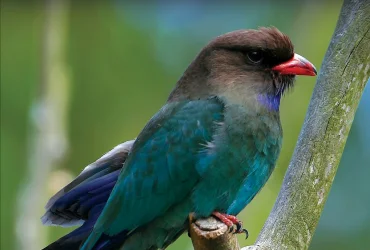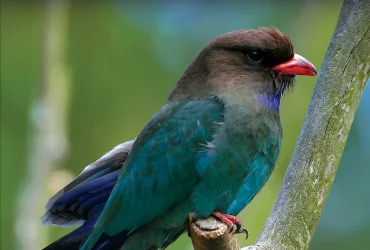Volume 4 | Number 1 | May 2012
 v4i1.59
v4i1.59ISSN: 1800-427X (print)
eISSN: 1800-427X (online)
DOI:10.47605/tapro.v4i1.59
Submitted date: 18 December 2011
Accepted date: 22 May 2012
Published date: 28 May 2012
Pp. 5–11.
Physoschistura tuivaiensis, A NEW SPECIES OF LOACH (TELEOSTEI: NEMACHEILIDAE) FROM THE TUIVAI RIVER, MANIPUR, INDIA
Yumnam Lokeshwor*, Waikhom Vishwanath & Keisham Shanta
*Corresponding author. E-mail: lokeyum24@gmail.com
Abstract
Physoschistura tuivaiensis is described from Likhailok on the Tuivai River, a tributary of the Brahmaputra River in southern Manipur, India. It is distinguished from congeneric species except P. shanensis and P. yunnaniloides by having a complete lateral line. It can be distinguished from those two species by the presence of 12-14 dark olivaceous blotches on the flank, and 15-17 dark olivaceous saddles on the back, more branched caudal fin rays, and 4+8 pores in the infraorbital canal. Examination of the holotype of Physoschistura elongata shows lip morphology different from Physoschistura, and the species is referred tentatively to Schistura.
Key words : Anatomy, freshwater, morphology, taxonomy, Brahmaputra River
Section Editor: Sven O Kullander
eISSN: 1800-427X (online)
DOI:10.47605/tapro.v4i1.59
Submitted date: 18 December 2011
Accepted date: 22 May 2012
Published date: 28 May 2012
Pp. 5–11.
Physoschistura tuivaiensis, A NEW SPECIES OF LOACH (TELEOSTEI: NEMACHEILIDAE) FROM THE TUIVAI RIVER, MANIPUR, INDIA
Yumnam Lokeshwor*, Waikhom Vishwanath & Keisham Shanta
*Corresponding author. E-mail: lokeyum24@gmail.com
Abstract
Physoschistura tuivaiensis is described from Likhailok on the Tuivai River, a tributary of the Brahmaputra River in southern Manipur, India. It is distinguished from congeneric species except P. shanensis and P. yunnaniloides by having a complete lateral line. It can be distinguished from those two species by the presence of 12-14 dark olivaceous blotches on the flank, and 15-17 dark olivaceous saddles on the back, more branched caudal fin rays, and 4+8 pores in the infraorbital canal. Examination of the holotype of Physoschistura elongata shows lip morphology different from Physoschistura, and the species is referred tentatively to Schistura.
Key words : Anatomy, freshwater, morphology, taxonomy, Brahmaputra River
Section Editor: Sven O Kullander
 v4i1.58
v4i1.58ISSN: 1800-427X (print)
eISSN: 1800-427X (online)
DOI:10.47605/tapro.v4i1.58
Published date: 28 May 2012
Pp. 1–4
EDITORIAL : How embarrassing can it get? Or: Taxonomy undermined
Sven O Kullander
Section Editor: Taprobanica, the journal of Asian Biodiversity
Whereas biological systematics and taxonomy are probably about the same kind of scientific enterprise, they were separated by Ernst Mayr in his classical text book, and taxonomy became cemented as a subset of systematics. A little over 40 years have passed since these definitions were expressed, and the work in which they appeared has become obsolete with the appearance of new technology and new philosophy about what are the fundamental aspects of species and higher taxa, especially with the development of phylogenetic systematics and facility of studying factors of inheritance at molecular level. Nevertheless, biological systematics remains the fundamental powerful scientific domain for understanding and expressing biological diversity, and keeps its definitions.
eISSN: 1800-427X (online)
DOI:10.47605/tapro.v4i1.58
Published date: 28 May 2012
Pp. 1–4
EDITORIAL : How embarrassing can it get? Or: Taxonomy undermined
Sven O Kullander
Section Editor: Taprobanica, the journal of Asian Biodiversity
Whereas biological systematics and taxonomy are probably about the same kind of scientific enterprise, they were separated by Ernst Mayr in his classical text book, and taxonomy became cemented as a subset of systematics. A little over 40 years have passed since these definitions were expressed, and the work in which they appeared has become obsolete with the appearance of new technology and new philosophy about what are the fundamental aspects of species and higher taxa, especially with the development of phylogenetic systematics and facility of studying factors of inheritance at molecular level. Nevertheless, biological systematics remains the fundamental powerful scientific domain for understanding and expressing biological diversity, and keeps its definitions.
Hubungi Kami
The ultimate aim of the journal is to provide an effective medium for communication of the latest and best scientific information.
Copyright © 2020 Taprobanica. All Rights Reserved
Jasa Pembuatan Website by IKT




